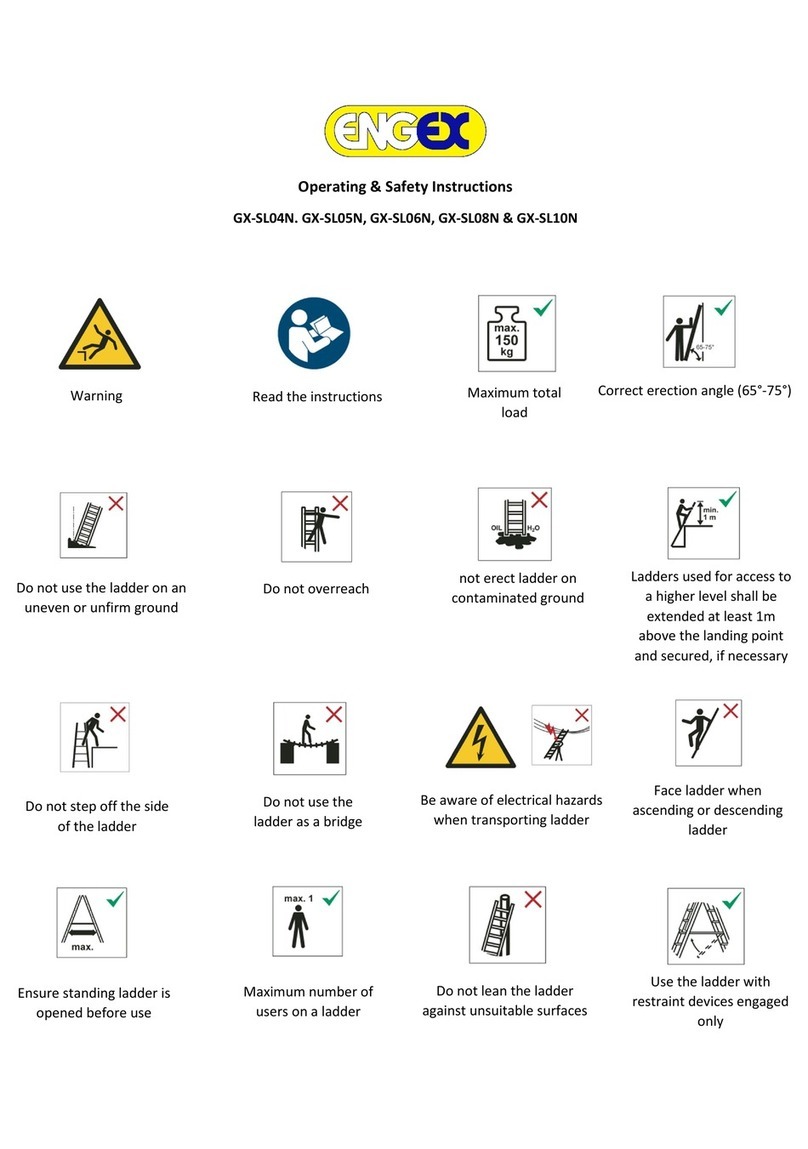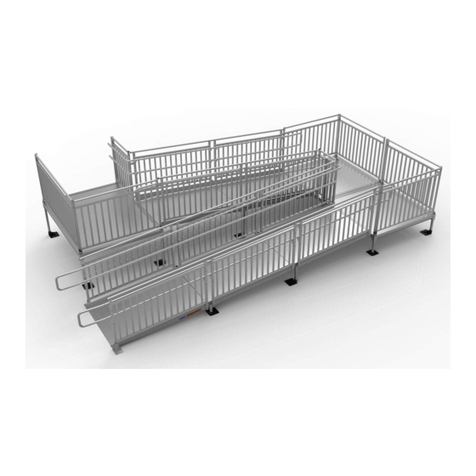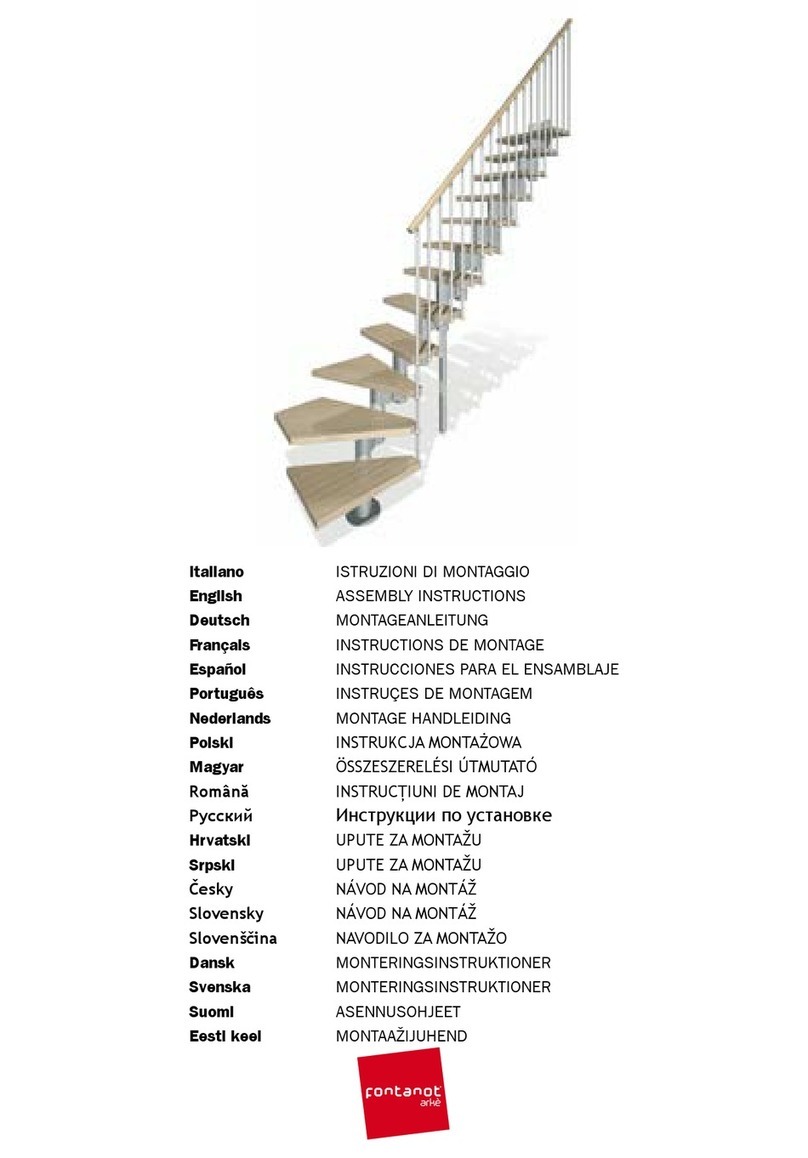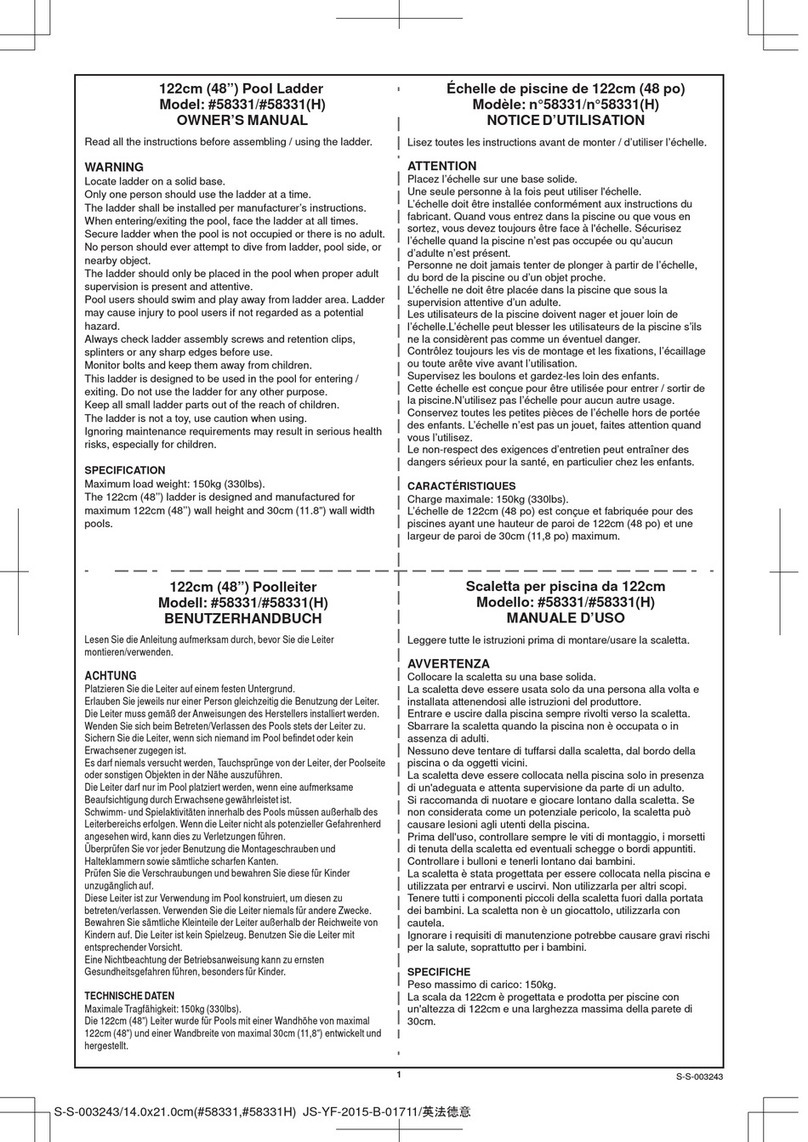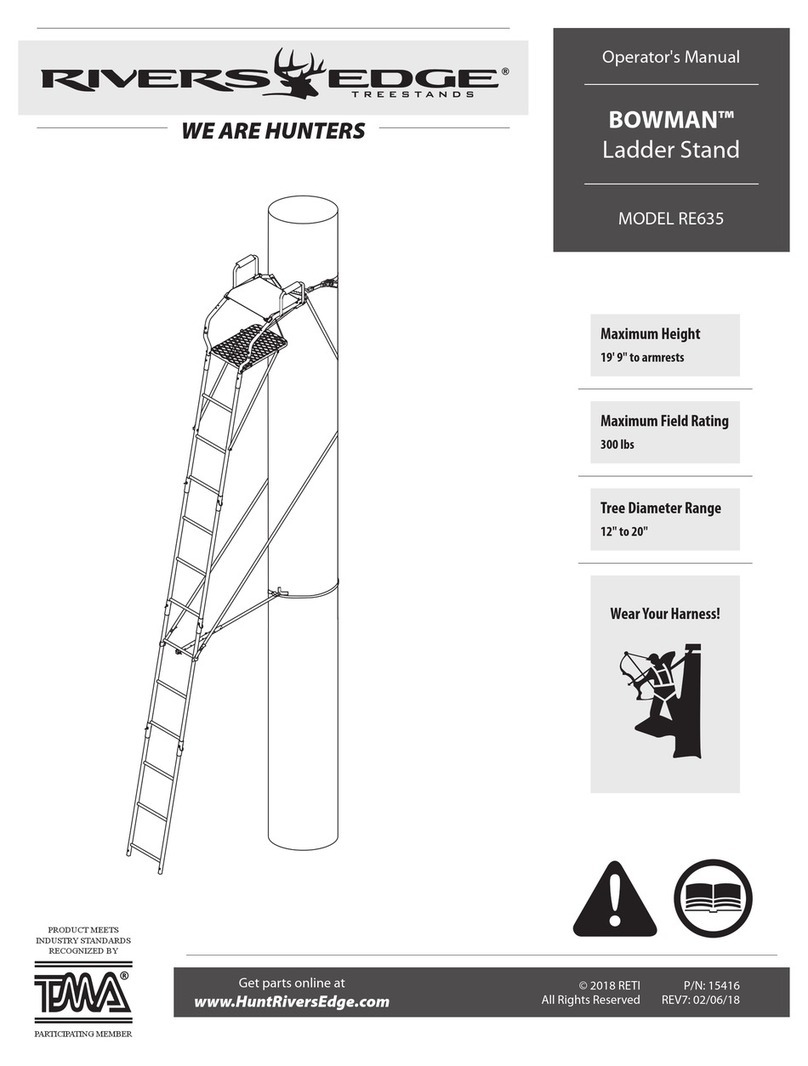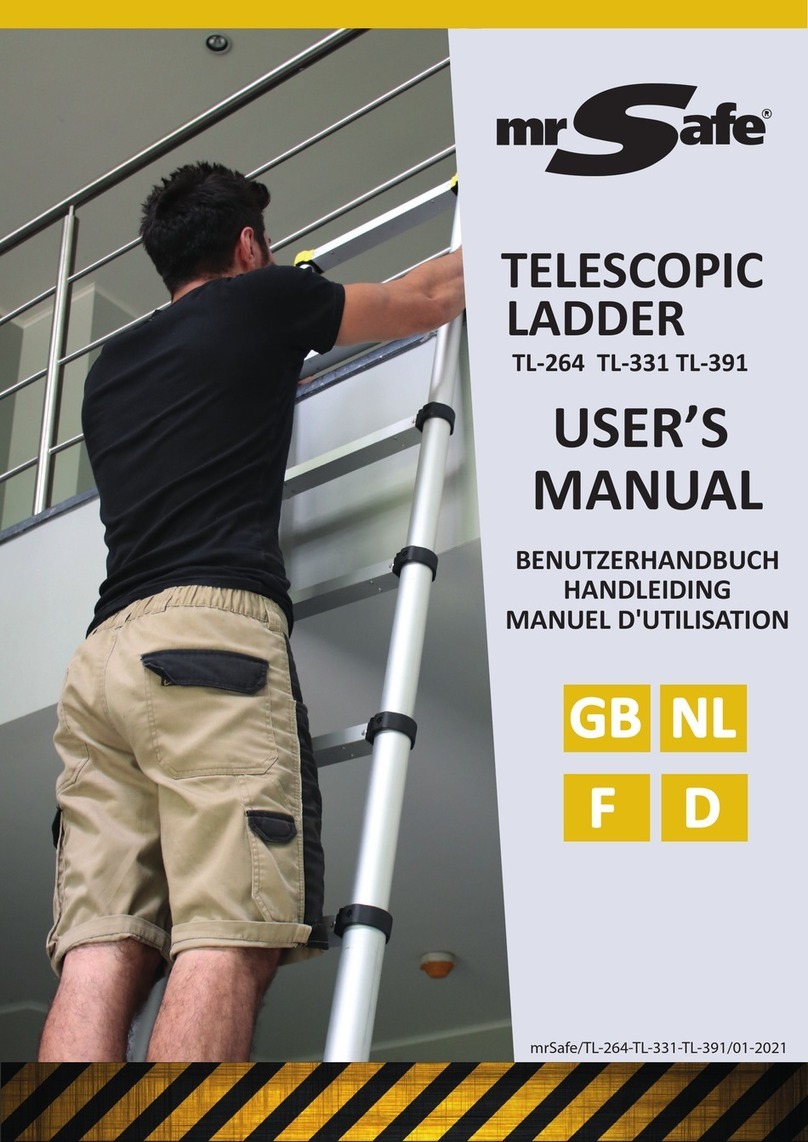Green Brook LAD4 Firmware update

F R PR FESSI NAL USE NLY
EN 131
Safety Instructions
for Fibreglass Swingback Ladders
Part No’s:
LAD4, LAD5, LAD6, LAD7, LAD8, LAD9 & LAD10
Swingback Ladder Ins Dec 18.qx _Layout 1 07/12/2018 13:31 Page 1

Do not use the ladder on an unlevel or unfirm base
Do not overreach
Warning! Fall from the ladder
Read the instructions
Maximum total load
Swingback Ladder Ins Dec 18.qx _Layout 1 07/12/2018 13:31 Page 2

Do not erect ladder on contaminated ground
Ladders used for access to a higher level shall be extended at least
1m above the landing point and secured, if necessary
Do not step off the side of a ladder
Do not use the ladder as a bridge
Be aware of electrical hazards when transporting ladder
Swingback Ladder Ins Dec 18.qx _Layout 1 07/12/2018 13:31 Page 3

Use the ladder with restraint devices engaged only
Maximum number of users on ladder
Do not lean the ladder against unsuitable surfaces
Face ladder when ascending or descending ladder
Ensure standing ladder is fully
opened before use
Swingback Ladder Ins Dec 18.qx _Layout 1 07/12/2018 13:31 Page 4

perating & Safety Instructions:
LAD4
Steps 3
Weight 6.1kg
Max Load
150kg
L1mm 1140
L2mm
875
Max Standing height:
approx. 0.26m
Max
Standing
height
LAD5
Steps 4
Weight 7.5kg
Max Load
150kg
L1mm 1440
L2mm
1070
Max Standing height:
approx. 0.54m
Max
Standing
height
Swingback Ladder Ins Dec 18.qx _Layout 1 07/12/2018 13:31 Page 5

LAD6
Steps 5
Weight 8.7kg
Max Load
150kg
L1mm 1740
L2mm
1265
Max Standing height:
approx. 0.82m
Max
Standing
height
LAD7
Steps 6
Weight 10.5kg
Max Load
150kg
L1mm 2040
L2mm
1465
Max Standing height:
approx. 1.10m
Max
Standing
height
perating & Safety Instructions:
Swingback Ladder Ins Dec 18.qx _Layout 1 07/12/2018 13:31 Page 6

LAD8
Steps 7
Weight 11.6kg
Max Load
150kg
L1mm 2340
L2mm
1665
Max Standing height:
approx. 1.38m
Max
Standing
height
LAD9
Steps 8
Weight 13.7kg
Max Load
150kg
L1mm 2640
L2mm
1855
Max Standing height:
approx. 1.65m
Max
Standing
height
perating & Safety Instructions:
Swingback Ladder Ins Dec 18.qx _Layout 1 07/12/2018 13:31 Page 7

LAD10
Steps 9
Weight 14.9kg
Max Load
150kg
L1mm 2940
L2mm
2055
Max Standing height:
approx. 1.93m
Max
Standing
height
perating & Safety Instructions:
Professional use
Swingback Ladder Ins Dec 18.qx _Layout 1 07/12/2018 13:31 Page 8

1. Check before using the ladder.
a) Ensure that you are fit enough to use a ladder. Certain
medical conditions or medication, alcohol or drug abuse
could make ladder use unsafe.
b) Prevent damage of the ladder when transporting e.g. by
fastening and, ensure they are suitably placed to prevent
damage.
c) Inspect the ladder after delivery. Before every use visually
check the ladder is not damaged and is safe to use. Do
not use a damaged ladder.
d) Visually check the ladder at the start of each working day
when the ladder is to be used.
e) For professional users regular periodic inspection is required.
f) Ensure the ladder is suitable for the task.
g) Do not use a damaged ladder.
h) Do not use the ladder if contaminated, e.g. with wet paint,
mud, oil or snow.
i) For professional use a risk assessment shall be carried out
respecting the legislation in the country of use.
j) Do not modify the ladder design.
a) Locking devices, if fitted, shall be fully secured before use.
b) The ladder shall be on an even, level and unmovable base.
c) The ladder shall never be repositioned from above.
d) When positioning the ladder take into account risk of
collision with the ladder e.g. from pedestrians, vehicles or
doors; Secure doors (not fire exits) and windows where
possible in the work area.
e) Identify any electrical risks in the work area, such as
overhead lines or other exposed electrical equipment.
2. Positioning and erecting the ladder.
Swingback Ladder Ins Dec 18.qx _Layout 1 07/12/2018 13:31 Page 9

f) The ladder shall be stood on its feet, not the rungs or treads.
g) Ladders shall not be positioned on slippery surfaces (such
as ice, shiny surfaces or significantly contaminated solid
surfaces) unless additional effective measures are taken to
prevent the ladder slipping or ensuring contaminated
surfaces are sufficiently clean.
h) Ladder shall never be moved from the top.
2. Positioning and erecting the ladder. (continued)
a) Do not exceed the maximum permissible load for the type
of ladder.
b) Do not overreach; users should keep their belt buckle
(navel) inside the stiles and both feet on the same
step/rung throughout the task.
c) Do not step off a leaning ladder at a higher level without
additional security, such as tying off or use of a suitable
stability device.
d) Do not use standing ladders for access to another level.
e) Do not stand on the top three rungs of a leaning ladder.
f) Do not stand on the top two steps/rungs of a standing
ladder without a platform and hand/knee rail.
g) Do not stand on the top four steps/rungs of a standing
ladder with an extending ladder at the top.
3. Using the ladder.
Swingback Ladder Ins Dec 18.qx _Layout 1 07/12/2018 13:31 Page 10

h) Ladders should only be used for light work of short duration.
i) Use non-conductive ladders for unavoidable live electrical
work.
j) Do not use the ladder outside in adverse weather
conditions, such as strong wind.
k) Take precautions against children playing on the ladder.
l) Secure doors (not fire exits) and windows where possible in
the work area.
m) Do not ascend or descend unless you are facing the
ladder.
n) Keep a secure grip on the ladder when ascending and
descending; Maintain a handhold whilst working from a
ladder or take additional safety precautions if you cannot.
o) Do not use the ladder as a bridge.
p) Do not wear unsuitable footwear when climbing a ladder.
q) Avoid excessive side loadings e.g. drilling brick and
concrete.
r) Do not spend long periods on a ladder without regular
breaks (tiredness is a risk).
s) Leaning ladders used for access to a higher level should be
extended at least 1 m above the landing point.
t) Do not carry equipment which is heavy or difficult to handle
while using a ladder.
u) Avoid work that imposes a sideways load on ladders, such
as side-on drilling through solid materials (e.g. brick or
concrete).
v) Maintain a handhold whilst working from a ladder or take
additional safety precaution if you cannot.
3. Using the ladder. (continued)
Swingback Ladder Ins Dec 18.qx _Layout 1 07/12/2018 13:31 Page 11

w) Standing ladders shall not be used as leaning ladders unless
they are designed for that purpose.
x) Do not move a ladder while standing on it.
y) For outdoor use caution to the wind.
z) Only use the ladder in the direction as indicated, only if
necessary due to design of ladder.
aa) Any horizontal surface which looks like a platform on a
standing ladder that is not designed for standing on (e.g. a
plastic work tray) shall be clearly indicated on that surface,
only if necessary due to design of ladder.
The rated load of plastic work tray is 10kg.
3. Using the ladder. (continued)
4. Repair, maintenance and storage.
Repairs and maintenance shall be carried out by a competent person and be in
accordance with the producers instruction.
For repair and replacement of parts, e.g. feet, if necessary contact the producer or
distributor.
Ladders should be stored in accordance with the producer’s instructions.
Ladders made of or using thermoplastic, thermosetting plastic and reinforced plastic
materials should be stored out of direct sunlight.
Ladders made of wood should be stored in a dry place and shall not be coated with
opaque and vapour-tight paints.
The important considerations when storing a ladder (not in use) should include the
following:
- Is the ladder stored away from areas where its condition could deteriorate more
rapidly (e.g. dampness, excessive heat, or exposed to the elements).
Swingback Ladder Ins Dec 18.qx _Layout 1 07/12/2018 13:31 Page 12

- Is the ladder stored in a position which helps it to remain straight (e.g. hung by the
stiles on proper ladder brackets or laid on a flat clutter free surface).
- Is the ladder stored where it cannot be damaged by vehicles, heavy objects, or
contaminants?
- Is the ladder stored where it cannot cause a trip hazard or an obstruction.
- Is the ladder stored securely where it cannot be easily used for criminal purposes.
- If the ladder is permanently positioned (e.g. on scaffolding), is it secured against
unauthorized climbing (e.g. by children).
4. Repair, maintenance and storage. (continued)
MAINTENANCE AND ST RING Y UR LADDER:
p Keep the ladder in a clean, dry place.
p Hold the ladder firmly when carrying it.
p ever store materials on your ladder.
p Keep your ladder clean and free from any foreign matter.
p Clean the ladder after each use.
p Regularly check the parts and hinges of the ladder. Oil the hinges regularly, but
do so carefully to ensure no oil drips on the rungs or side rails.
For regular inspection, the following items shall be taken into account:
- check that the stiles/legs (uprights) are not bent, bowed, twisted, dented,
cracked, corroded or rotten.
- check that the stiles/legs around the fixing points for other components are in
good condition.
- check that fixings (usually rivets, screws or bolts) are not missing, loose, or
corroded.
- check that rungs/steps are not missing, loose, excessively worn, corroded or
damaged.
- check that the hinges between front and rear sections are not damaged, loose
or corroded.
- check that the locking stays horizontal, back rails and corner braces are not
missing, bent, loose, corroded or damaged.
- check that the rung hooks are not missing, damaged, loose or corroded and
engage properly on the rungs.
Swingback Ladder Ins Dec 18.qx _Layout 1 07/12/2018 13:31 Page 13

- check that guide brackets are not missing, damaged, loose or corroded and
engage properly on the mating stile.
- check that ladder feet / end caps are not missing, loose, excessively worn,
corroded or damaged.
- check that the entire ladder is free from contaminants (e.g. dirt, mud, paint, oil or
grease).
- check that locking catches (if fitted) are not damaged or corroded and function
correctly.
- check that the platform (if fitted) has no missing parts or fixings and is not
damaged or corroded.
If any of the above checks cannot be fully satisfied, you should N T use the ladder.
Reasons for accidents:-
The following list of hazards and examples of their causes, which is not exhaustive, are
common reasons for accidents encountered when using ladders and are the basis on
which the information in this manual has been developed:
a) Loss of stability:
1) Incorrect positioning of the ladder (such as incorrect angle for leaning ladder or
not fully opening a standing ladder).
2) slide outwards at the bottom (such as bottom of leaning ladders sliding away
from the wall).
3) side slip, falling sideways and top flip (such as overreaching or fragile top contact
surface).
4) falling sideways.
5) condition of the ladder (such as missing anti-slip feet).
6) stepping off an unsecured ladder at height.
7) ground conditions (such as unstable soft ground, sloping ground, slippery surfaces
or contaminated solid surfaces).
8) adverse weather conditions (such as windy conditions).
9) collision with the ladder (such as vehicle or door).
10) incorrect choice of ladder (such as too short, unsuitable task).
Swingback Ladder Ins Dec 18.qx _Layout 1 07/12/2018 13:31 Page 14

1) Transferring the ladder to the work position.
2) erecting and dismantling the ladder.
3) carrying items up the ladder.
c) Slip trip and fall of user:
1) Inappropriate footwear.
2) contaminated rungs or Steps.
3) unsafe user practices (such as climbing 2 rungs at a time, sliding down stiles).
4) ground conditions (such as unstable soft ground, sloping ground, slippery surfaces
or contaminated solid surfaces).
d) Structural failure of ladder:
1) condition of the ladder (such as damaged stiles).
2) overloading the ladder.
3) unintended use.
e) Electrical hazards:
1) Unavoidable live working (e. g. fault finding).
2) positioning ladders too close to live electrical equipment (such as overhead
power lines).
3) ladders damaging electrical equipment (such as covers or protective insulation).
4) incorrect selection of type of ladder for electrical work.
b) From handling:
Swingback Ladder Ins Dec 18.qx _Layout 1 07/12/2018 13:31 Page 15

PLEASE KEEP THESE INSTRUCTI NS SAFE
F R FUTURE REFERENCE
Issue no: 705387
WEST R AD . HARL W
ESSEX . CM20 2BG . UK
info@greenbrook.co.uk
www.greenbrook.co.uk
GUARANTEE
Your GreenBrook Ladder is
guaranteed for 1 year from the
date of purchase.
This is in addition to your statutory rights.
Swingback Ladder Ins Dec 18.qx _Layout 1 07/12/2018 13:31 Page 16
This manual suits for next models
6
Table of contents
Other Green Brook Ladder manuals
Popular Ladder manuals by other brands
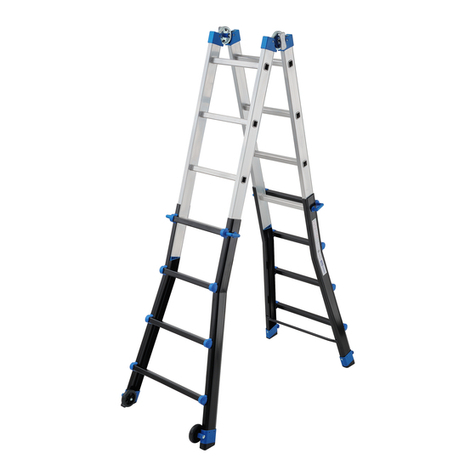
GIERRE
GIERRE AL065 Operating and maintenance instructions

Leroy Merlin
Leroy Merlin AL040 SKY Operating and maintenance instructions
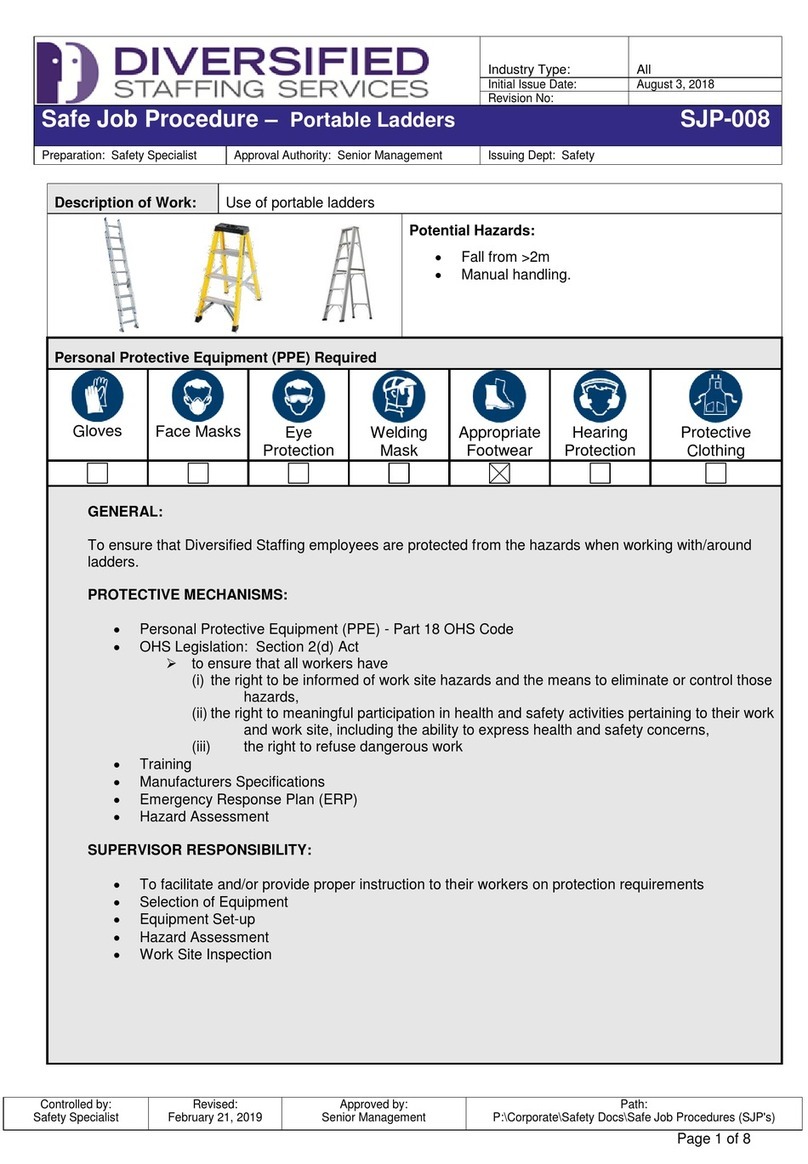
DIVERSIFIED
DIVERSIFIED SJP-008 manual
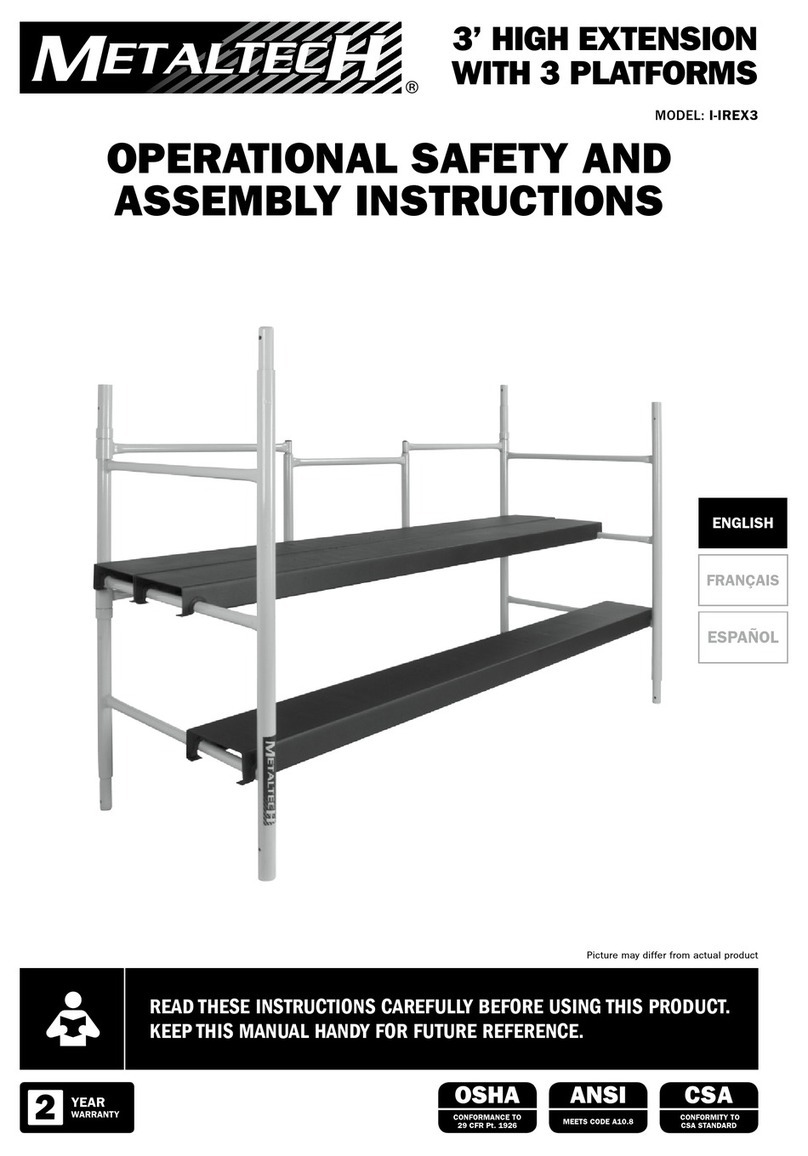
MetalTech
MetalTech I-IREX3 OPERATIONAL SAFETY AND ASSEMBLY INSTRUCTIONS
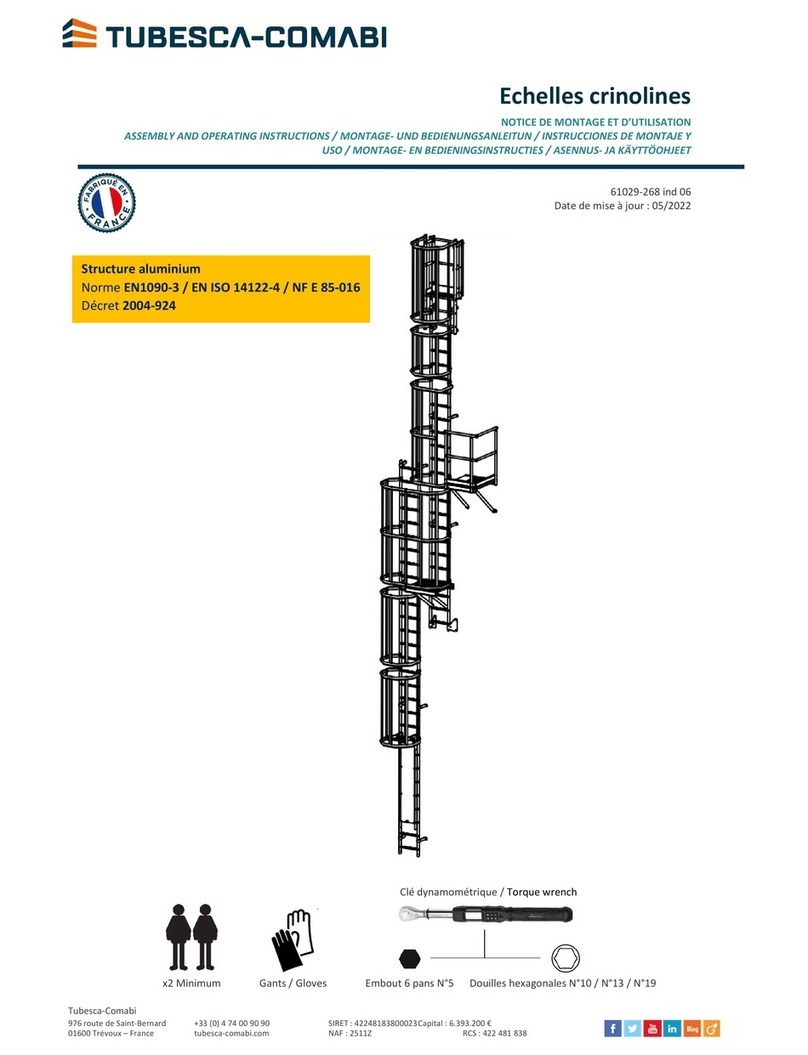
TUBESCA-COMABI
TUBESCA-COMABI Echelles crinolines Assembly and operating instructions
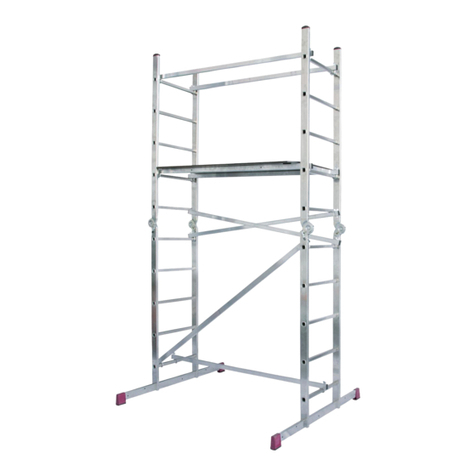
KRAUSE
KRAUSE 916341 Instructions for assembly and use
